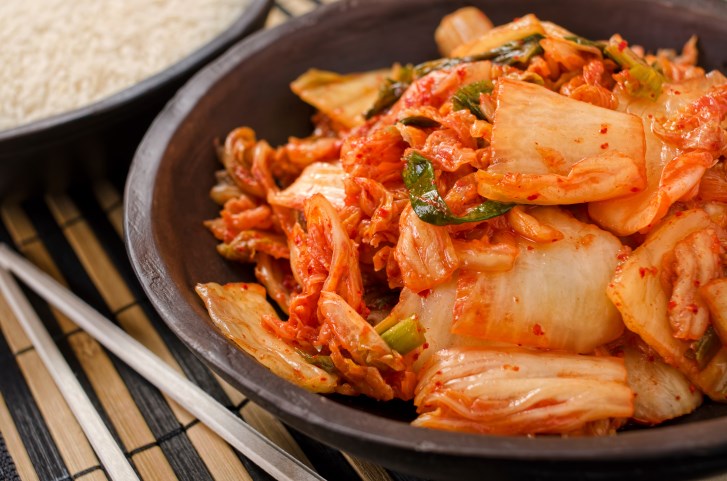From the folks that brought us Gangnam Style and the World’s Largest Ikea Store also comes a traditional fermented side dish that really packs a spicy punch. It’s called kimchi, and it seems to be one of those things that you either love or hate. Kimchi is to Korea what cheese is to France and what craft beer is to Vancouver, so you can bet that they have several different types and ingredients and variations that haven’t even begun to surface in the west. Koreans don’t play around when it comes to fermentation.
Koreans consume 1.6 million tons of kimchi a year, and like many delicacies around the globe, Korean’s fermentation adventure started as a way to extend storability of foods throughout the winter months. The addition of fish and seafood was introduced to assist the fermentation process and also provide much needed nutrients that otherwise would not have been attainable that time of the year, such as calcium and protein.
The word kimchi comes from the Korean word shimchae, which translates to “salting of vegetables.”
Its origins trace back to the seventh century, where kimchi started just like its name suggests – as salted veggies. But it morphed quickly, with all sorts of spices and flavours being added. It wasn't until the 18th century that the chili pepper was introduced as an ingredient, which most of us know today as one of the major ingredients.
Today kimchi is the most famous fermented foods in Korea, so much so that it is a must-have even for Korean astronauts in space (South Korean scientists spent millions to successfully engineer kimchi fit for space travel).
Kimchi comes in many different varieties and flavours, depending on one’s preference. There’s even such a thing as fruit kimchi, but here in Canada we’re used to it containing various vegetables, including Chinese cabbage, leek, scallions, radish, cucumber, ginseng, garlic, cayenne peppers and Indian mustard leaves. Vegetables are mixed with desired spices and seasonings and fermented for several days.
So what benefits do kimchi bring, besides being a party in your mouth?
Digestive health
Because kimchi is a fermented food, it’s packed with tons of beneficial bacteria that aid in your digestive process. Fermentation also enhances the flavour and nutrient content of food. Kimchi can also aid in cleaning up the intestines by helping you rid wastes.
Boosts immune system
Beneficial ingredients such as ginger, garlic and pepper are known as natural immune boosters and infection fighters as well as great soldiers in the war against cold and flu.
Anti-aging benefits
High in anti-aging vitamins A and C. A study evaluating the anti-aging activity of kimchi has revealed that kimchi helps in regulating and slowing down the inflammation that speeds up our natural aging process.
Lowers cholesterol
Allicin is a major component of garlic, which is a major component of kimchi, helps to lower cholesterol levels, reducing the risk of cardiovascular disease. Selenium, which is also found in garlic, prevents the buildup of plaque decreasing your chances of atherosclerosis.
Recipe:
Kimchi stew
Ingredients:
2 tbsp coconut oil
2 green onion ends trimmed, green and white parts thinly sliced and kept separate
1 white onion sliced
4 medium garlic cloves, minced (about 4 teaspoons)
1/2 pound squash, ends trimmed, cut into 1/2-inch cubes
1/2 pound shiitakes mushrooms, ends removed, caps sliced
1 bunch of kale, ends trimmed, leaves roughly chopped
2 cups kimchi, roughly chopped
1/2 cup kimchi liquid
4 cups vegetable or chicken broth
2 cups water
1 tbsp Tamari sauce
2 tbsp miso paste
2 tbsp dried chili flakes(optional)
Directions:
• Warm oil into a medium saucepan over medium-high heat.
• Add both onions and cook, stirring occasionally, until fragrant, about 30 seconds.
• Add squash and shiitakes, stir well, and cook until squash starts to soften, 3 to 5 minutes.
• Add chopped kale and cook, stirring often, until leaves turn bright green and wilt slightly, about 2 minutes.
• Stir in kimchi, kimchi liquid, broth, water, tamari sauce and miso
• Bring to a boil over high heat, reduce heat to a strong simmer.
• Cook until kale is tender and soup has slightly thickened, about 10 minutes.
• Season to taste with more salt and chili flakes if desired.
• Serve soup immediately, sprinkled with scallion greens or cilantro as garnish.



